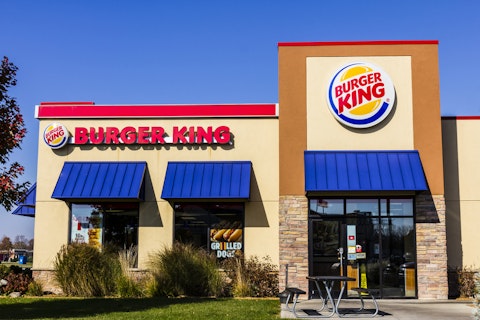Pershing Square Holdings, Ltd., an investment management firm, published its second-quarter 2021 investor letter – a copy of which can be downloaded here. For the first half of 2021 and year-to-date through August 17, 2021, the Company’s NAV per share, including dividends, increased by 7.3% and 5.8%, respectively, and the Company’s share price increased by 4.7% and 2.0%, respectively, compared with the S&P 500 which returned 15.2% and 19.5% over the same period. You can take a look at the fund’s top 5 holdings to have an idea about their top bets for 2021.
In the Q2 2021 investor letter of Pershing Square Holdings, the fund mentioned Restaurant Brands International Inc. (NYSE: QSR) and discussed its stance on the firm. Restaurant Brands International Inc. is an Oakville, Canada-based fast-food restaurant company with a $19.07 billion market capitalization. QSR delivered a 1.10% return since the beginning of the year, while its 12-month returns are up by 7.43%. The stock closed at $61.53 per share on September 28, 2021.
Here is what Pershing Square Holdings has to say about Restaurant Brands International Inc. in its Q2 2021 investor letter:
“QSR’s franchised business model is a high-quality, capital-light, growing annuity that generates high-margin brand royalty fees from three leading brands: Burger King, Tim Hortons and Popeyes. The company has nimbly navigated the COVID-19 pandemic and continues to make progress on returning its brands to sustainable long-term growth.
Since the onset of the COVID-19 pandemic, the company has bolstered its safety procedures and is accelerating its digital investments by expanding its delivery footprint, modernizing its drive-thru experience, increasing mobile ordering adoption, and improving its loyalty programs. As the global recovery continues to be uneven, these initiatives will allow the company and its franchisees to serve customers in a safe and reliable manner.
Each of the company’s brands are at various stages in recovery, with Burger King and Popeyes having returned to growth, while Tim Hortons is well on its way to recovering. On a two-year basis, same-store-sales grew 2.4% at Burger King and 24.4% at Popeyes during the last quarter. Meanwhile, Tim Hortons in Canada has improved to a mid-single digit decline in July, with each month during the second quarter showing sequential improvement. Tim Hortons’ slower recovery is largely driven by strict COVID-19 restrictions in Canada, which were only recently lifted in large provinces such as Ontario. In rural and suburban parts of Canada where restrictions were lifted earlier, Tim Hortons has already returned to growth. Given the habitual nature of Tim Hortons’ customer base, the recovery in sales will be tied to mobility and reopening.
The company expects to return to its historical mid-single-digit unit growth this year, and recently announced expansions for both Tim Hortons and Popeyes in large international markets. As underlying sales trends at each of its brands continue to improve, and as the impact from COVID-19 restrictions ease, we believe Restaurant Brands’ share price will more accurately refl ect our view of its improving business fundamentals.”

Jonathan Weiss/Shutterstock.com
Based on our calculations, Restaurant Brands International Inc. (NYSE: QSR) was not able to clinch a spot in our list of the 30 Most Popular Stocks Among Hedge Funds. QSR was in 22 hedge fund portfolios at the end of the first half of 2021, compared to 26 funds in the previous quarter. Restaurant Brands International Inc. (NYSE: QSR) delivered a -4.07% return in the past 3 months.
Hedge funds’ reputation as shrewd investors has been tarnished in the last decade as their hedged returns couldn’t keep up with the unhedged returns of the market indices. Our research has shown that hedge funds’ small-cap stock picks managed to beat the market by double digits annually between 1999 and 2016, but the margin of outperformance has been declining in recent years. Nevertheless, we were still able to identify in advance a select group of hedge fund holdings that outperformed the S&P 500 ETFs by 115 percentage points since March 2017 (see the details here). We were also able to identify in advance a select group of hedge fund holdings that underperformed the market by 10 percentage points annually between 2006 and 2017. Interestingly the margin of underperformance of these stocks has been increasing in recent years. Investors who are long the market and short these stocks would have returned more than 27% annually between 2015 and 2017. We have been tracking and sharing the list of these stocks since February 2017 in our quarterly newsletter.
At Insider Monkey, we scour multiple sources to uncover the next great investment idea. For example, lithium mining is one of the fastest growing industries right now, so we are checking out stock pitches like this emerging lithium stock. We go through lists like the 10 best EV stocks to pick the next Tesla that will deliver a 10x return. Even though we recommend positions in only a tiny fraction of the companies we analyze, we check out as many stocks as we can. We read hedge fund investor letters and listen to stock pitches at hedge fund conferences. You can subscribe to our free daily newsletter on our homepage.
Disclosure: None. This article is originally published at Insider Monkey.




